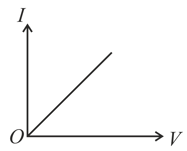Where did the Non-Cooperation Movement witness the most intense protests?
Important Questions on Current Electricity
characteristic of a copper wire of length and area of cross-section is shown in figure. The slope of the curve becomes

The following item consist of two statements, Statement I and Statement II. Examine these two statements carefully and select the correct answer using the code given below :
Statement I
The United Provinces during Non-Cooperation became one of the strongest bases of the Congress.
Statement II :
The literary outcrop of Non-Cooperation in Bengal was quite meagre compared to the days of the Swadeshi agitation.
Which of the following was/were the features of the Quit India Movement?
1. From the very beginning, it was a rural revolt.
2. It was essentially a moderate movement.
3. It was marked by the Unprecedented use of violence
4. It was marked by acute state repression.
Select the correct answer using the code given below.
: Conductivity always increases with decreases in the concentration of electrolyte.
: Molar conductivity always increases with decreases in the concentration of electrolyte.
The correct option among the following
Find the resistivity of the material of a metallic conductor of length and area of cross-section . The resistance of the conductor is .
Write the relationship between electrical resistance and electrical resistivity for a metallic conductor of cylindrical shape. Hence, derive the SI unit of electrical resistivity.
The following item consist of two statements, Statement I and Statement II. Examine these two statements carefully and select the correct answer using the code given below :
Statement I
Non-cooperation began in Punjab with the student movement inspired by Lala Lajpat Rai in January .
Statement II
The Sikh dominated central Punjab countryside was stirred by the powerful Akali upsurge.
Which movement was called off following the violence at 'Chauri Chaura' incident?
1. Khilafat Movement
2. Quit India Movement
3. Non Co-operation Movement
4. Home Rule Movement

